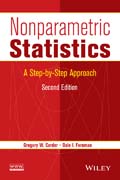
INDICE: Preface Chapter 1: Nonparametric Statistics: An Introduction 1.1. Objectives 1.2. Introduction 1.3. The Nonparametric Statistical Procedures Presented In This Book 1.4. Ranking Data 1.5. Ranking Data with Tied Values 1.6. Counts Of Observations 1.7. Summary 1.8. Practice Questions 1.9 Solutions To Practice Questions Chapter 2: Testing Your Data For Normality 2.1. Objectives 2.2. Introduction 2.3. Describing Data and The Normal Distribution 2.4. Computing And Testing Kurtosis And Skewness For Sample Normality 2.4.1. Sample Problem For Examining Kurtosis 2.4.2. Sample Problem For Examining Skewness 2.4.3. Examining Skewness And Kurtosis For Normality Using SPSS 2.5. The Kolmogorov–Smirnov One–Sample Test 2.5.1. Sample Kolmogorov–Smirnov One–Sample Test 2.5.2. Performing The Kolmogorov–Smirnov One–Sample Test Using SPSS 2.6. Summary 2.7. Practice Questions 2.8. Solutions To Practice Questions Chapter 3: Comparing Two Related Samples: The Wilcoxon Signed Ranks Test 3.1. Objectives 3.2. Introduction 3.3. Computing The Wilcoxon Signed Ranks Test Statistic 3.3.1. Sample Wilcoxon Signed Ranks Test For Small Samples 3.3.2. Confidence Interval for the Wilcoxon Signed Ranks Test 3.3.3. Sample Wilcoxon Signed Ranks Test For Large Samples 3.4. Computing the Sign Test 3.4.1. Sample Sign Test For Small Samples 3.4.2. Sample Sign Test For Large Samples 3.5. Performing the Wilcoxon Signed Ranks Test Using SPSS 3.6. Statistical Power 3.7. Examples from the Literature 3.8. Summary 3.9. Practice Questions 3.10. Solutions to Practice Questions Chapter 4: Comparing Two Unrelated Samples: The Mann–Whitney U Test 4.1. Objectives 4.2. Introduction 4.3. Computing the Mann–Whitney U Test Statistic 4.3.1. Sample Mann–Whitney U Test For Small Samples 4.3.3. Confidence Interval for the Difference Between Two Location Parameters 4.3.4. Sample Mann–Whitney U Test For Large Samples 4.4. Computing the Kolmogorov–Smirnov Two–Sample Test Statistic 4.4.1 Sample Kolmogorov–Smirnov Two–Sample Test 4.5. Performing the Mann–Whitney U Test and the Kolmogorov–Smirnov Two–Sample Test Using SPSS 4.6. Examples From The Literature 4.7. Summary 4.8. Practice Questions 4.9. Solutions to Practice Questions Chapter 5: Comparing More Than Two Related Samples: Friedman’s Test 5.1. Objectives 5.2. Introduction 5.3. Computing The Friedman’s Test Statistic 5.3.1. Sample Friedman’s Test (Small Data Samples without Ties) 5.3.2. Sample Friedman’s Test (Small Data Samples with Ties) 5.3.3. Performing The Friedman’s Test Using SPSS 5.3.4. Sample Friedman’s Test (Large Data Samples without Ties) 5.4. Examples From The Literature 5.5. Summary 5.6. Practice Questions 5.7. Solutions to Practice Questions Chapter 6: Comparing More Than Two Unrelated Samples: Kruskal–Wallis H Test 6.1. Objectives 6.2. Introduction 6.3. Computing The Kruskal–Wallis H Test Statistic 6.3.1. Sample Kruskal–Wallis H Test (Small Data Samples) 6.3.2. Performing The Kruskal–Wallis H Test Using SPSS 6.3.3. Sample Kruskal–Wallis H Test (Large Data Samples) 6.4. Examples From The Literature 6.5. Summary 6.6. Practice Questions 6.7. Solutions To Practice Questions Chapter 7: Comparing Variables Of Ordinal Or Dichotomous Scales: Spearman Rank–Order, Point–Biserial, And Biserial Correlations 7.1. Objectives 7.2. Introduction 7.3. The Correlation Coefficient 7.4. Computing The Spearman Rank–Order Correlation Coefficient 7.4.1. Sample Spearman Rank–Order Correlation (Small Data Sample without Ties) 7.4.2. Sample Spearman Rank–Order Correlation (Small Data Sample with Ties) 7.4.3. Performing The Spearman Rank–Order Correlation Using SPSS 7.5. Computing the Point–Biserial and Biserial Correlation Coefficients 7.5.1. Correlation of a dichotomous variable and an interval scale variable. 7.5.2. Correlation of a dichotomous variable and a rank–order variable. 7.5.3. Sample Point–Biserial Correlation (Small Data Samples) 7.5.4. Performing The Point–Biserial Correlation Using SPSS 7.5.5. Sample Point–Biserial Correlation (Large Data Samples) 7.5.6. Sample Biserial Correlation (Small Data Samples) 7.5.7. Performing The Point–Biserial Correlation Using SPSS 7.6. Examples From The Literature 7.7. Summary 7.8. Practice Questions 7.9. Solutions To Practice Questions Chapter 8: Tests For Nominal Scale Data: Chi–Square Tests 8.1. Objectives 8.2. Introduction 8.3. The Chi–Square Goodness–of–Fit Test 8.3.1. Computing The Chi–Square Goodness–of–Fit Test Statistic 8.3.2. Sample Chi–Square Goodness–Of–Fit Test (Category Frequencies Equal) 8.3.3. Sample Chi–Square Goodness–Of–Fit Test (Category Frequencies Not Equal) 8.3.4. Performing The Chi–Squared Goodness–Of–Fit Test Using SPSS 8.4. Chi–Square Test Of Independence 8.4.1. Computing the Chi–Square Test Of Independence 8.4.2. Sample Chi–Square Test Of Independence 8.4.3. Performing The Chi–Square Test Of Independence Using SPSS 8.5. The Fisher Exact Test 8.5.1. Computing the Fisher Exact Test for 2 ´ 2 Tables 8.5.2. Sample Fisher Exact Test 8.5.3. Performing the Fisher Exact Test Using SPSS 8.6. Examples From The Literature 8.7. Summary 8.8. Practice Questions 8.9. Solutions To Practice Questions Chapter 9: Test For Randomness: Runs Test 9.1. Objectives 9.2. Introduction 9.3. The Runs Test For Randomness 9.3.1. Sample Runs Test (Small Data Samples) 9.3.2. Performing The Runs Test Using SPSS 9.3.3. Sample Runs Test (Large Data Samples) 9.3.4. Sample Runs Test Referencing A Custom Value 9.3.5. Performing The Runs Test For A Custom Value Using SPSS 9.4. Examples From The Literature 9.5. Summary 9.6. Practice Questions 9.7. Solutions To Practice Questions Appendix A: SPSS at a Glance A.1. Introduction A.2. Opening SPSS A.3. Inputting Data A.4. Analyzing Data A.5. The SPSS Output Appendix B: Tables of Critical Values Table B.1: The Normal Distribution Table B.2: Chi–Squared Distribution Table B.3: Critical Values for the Wilcoxon Signed Rank Test Statistics, T. Table B.4: Critical Values for the Mann–Whitney U Test Statistic. Table B.5: Critical Values for the Friedman Test Statistic, F r. Table B.6: The Critical Values for the Kruskal–Wallis H Test Statistic. Table B.7: Critical Values for the Spearman Rank–Order Correlation Coefficient, r s . Table B.8: Critical Values for the Pearson Product–Moment Correlation Coefficient, r. Table B.9: Factorials. Table B.10: Critical Values for the Runs Test for Randomness.
- ISBN: 978-1-118-84031-3
- Editorial: Wiley–Blackwell
- Encuadernacion: Cartoné
- Páginas: 224
- Fecha Publicación: 16/05/2014
- Nº Volúmenes: 1
- Idioma: Inglés
- Inicio /
- /
